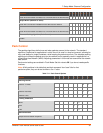
7: Setup Mode: Channel Configuration
WiBox® 2100E Device Server User Guide 63
Telnet Terminal Type
This parameter displays only if you enabled the terminal type option in Disconnect Mode. With
this option enabled, you can use the terminal name for the Telnet terminal type. Enter only one
name.
With terminal type option enabled, the unit also reacts to the EOR (end of record) and binary
options, useful for applications like terminal emulation to IBM hosts.
Channel (Port) Password
This parameter displays only if the channel (port) password option is enabled in Disconnect
Mode. With this option enabled, you can set a password on the serial port. Blank by default.
WLAN Settings
Without adequate protection, a wireless LAN is susceptible to access by unauthorized users. As
such, WiBox 2100E features the WPA security standard, based on IEEE802.11i and IEEE802.1X.
WEP is provided for backwards compatibility and interaction with older devices.
To modify WLAN settings, select 4 WLAN from the Change Setup menu.
Topology
Select Infrastructure (ESS) mode or Adhoc (IBSS) mode. Infrastructure mode communicates
with Access Points. Ad Hoc mode communicates only with other clients.
Topology 0=Infrastructure, 1=Adhoc (0) ? _
Network Name (SSID)
Enter the name of the network to which the WiBox 2100E will connect.
Network name (LTRX_IBSS) ? _
Adhoc Network Channel
When Adhoc is selected in the Topology parameter and the WiBox 2100E cannot find the
specified network, it creates one with that name by transmitting a beacon on the selected
channel.
Channel (11) ? _
Only channels allowed in the country for which the WiBox 2100E is designated can be selected.
The country displays in the Setup Mode settings overview.
Security Suite
The WiBox 2100E features WEP, WPA, and 802.11i/WPA2-Personal to secure all wireless
communication. WPA and 802.11i/WPA2-Personal are not available when Adhoc is selected as
the topology.
The 802.11i/WPA2-Personal mode is compliant with the Robust Secure Network that is specified
in the IEEE standard 802.11i. It enables the AES-based strong CCMP encryption.


















